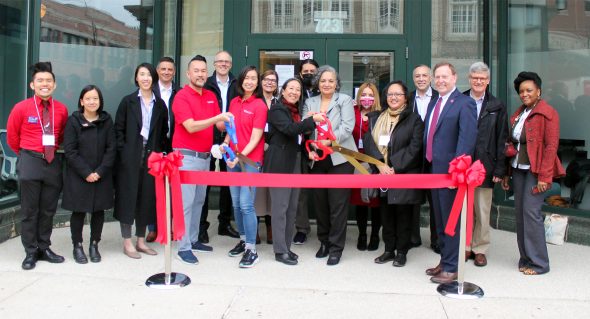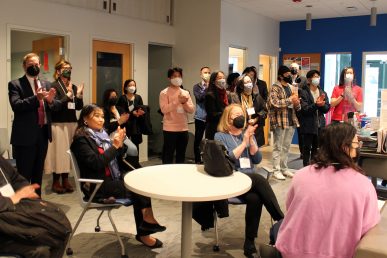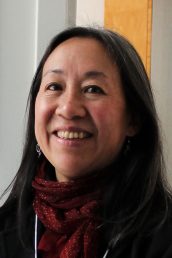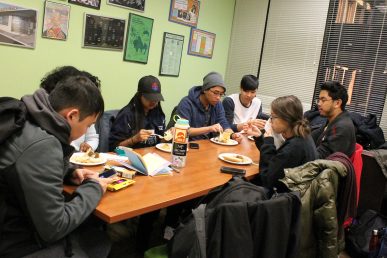Asian American Resource and Cultural Center opens in new home

As the founding director of the Asian American Resource and Cultural Center, Karen Su’s mission for the center 17 years ago was to provide a space at the University of Illinois Chicago where Asian American students could find a home on campus and connect to their communities.
Su, who served as the founding director from 2004 until 2013, said that by the time the first five years had passed she was aware that the center’s popularity proved that it was needed.
“At the fifth-anniversary celebration for AARCC we had a wishing wall and most of the wishes that were put on that wall were for AARCC to be bigger. It’s happening today, it’s bigger,” said Su, clinical assistant professor and director of undergraduate studies in the department of global Asian studies in the College of Liberal Arts and Sciences. “Having a place to gather and bring the community together so that you can connect is just really significant.”
On Wednesday, April 20, those wishes came true at a ribbon-cutting ceremony that formally opened the center’s first free-standing center at 723 W. Maxwell St. The event was attended by dozens of people including officials from UIC, students, alumni and community members including the first Asian American woman to be sworn into Chicago’s City Council, 11th Ward Ald. Nicole Lee, who was selected to represent the city’s Bridgeport and Chinatown neighborhoods.

Amalia Pallares, vice chancellor for diversity, equity and engagement, said the resource center came from students, faculty and community members seeking representation on the UIC campus. She said the center represented a vision of being a central site to engage, support and welcome Asian American students and faculty to UIC. She pointed out that for the first time, students in the fall will have the opportunity to major in and receive a Bachelor of Arts in Global Asian Studies, the first to be offered by a university in Chicago and the first in the Midwest, Pallares said.
“AARCC became the focus and the goal. It was not only a center for community and a center for engagement and congregation, but it was also a catalyst for dreams. We are now seeing the fruits of that vision, it’s now becoming a reality and I think this space represents that,” Pallares said.
Mark Martell, the center’s current director said the new space will open up opportunities to engage faculty and invite their courses to tour the facility and learn about its history and resources. He hoped that Asian American community organizations utilize it. His aim is to bolster its staff to engage alumni and work on fundraising initiatives for the students.
“This space was a result of student demands, so there is so much potential. I can really see AARCC grow in many ways,” said Martell.

During the event, Martell announced that a gallery in the new building featuring artwork by Asian American artists and students will “henceforth be known as the Dr. Karen Su Gallery. For her many years of service, devotion and commitment.”
In the early years, the center had a small space in Taft Hall and Su said that in those days the main priority was to continue many of the programs and services that students had started on their own as volunteers. These included celebrating Asian American Awareness Month, holding orientation activities to introduce campus resources to new students, and producing a campus resource book listing on and off-campus organizations among others. The center is responsible for the AANAPISI Initiative which supports the recruitment, retention, and graduation of Asian American and Pacific Islander students at the UIC. The initiative is fully funded by the U.S. Department of Education’s Asian American and Native American Pacific Islander-Serving Institutions Program.
“We also started new programs that a center could sustain in partnership with other campus units – a student leadership council and leadership retreat, an Asian American mentor program, year-round public events, and providing a space on campus that was literally a home away from home for students who would eat meals in the center, do homework and socialize,” Su said.
After its first center was opened, continued student interest required an expansion and it took over more space at Taft Hall.

Alumni like Nina Cassandra Ambida, who graduated in 2019 with a bachelor of science in nursing degree, said the center served as her “safe space” to relax with friends, study and learn about other resources on campus.
“Honestly AARCC did so much more for me than that. It was a community that made me feel like I belonged. Especially when growing up I didn’t go to school in areas with that many students of Asian descent,” said Ambida, who is now an elementary school nurse. “AARCC was my home during all of my undergrad years.”
Another alumnus, Tito Catuncan, who graduated with a double major in psychology and sociology in 2012, was involved in the center’s Asian American Mentor Program (AAMP). Catuncan said as a mentee to several Asian American peer mentors through the center he learned about other Asian American organizations.
“Through AARCC and AAMP, I was also introduced to other Asian American organizations on campus such as the Asian American Coalition Committee, Asian American Students in Alliance, and Filipinos in Alliance which got me making so many Asian American friends for the first time in my life while also learning so much about our diverse cultures and experiences,” said Catuncan, who is a licensed clinical social worker in Minnesota.
He said the larger space speaks to the need and impact of the Asian American community on the UIC campus.
Faith George, a junior majoring in neuroscience, said among the first friends she met at UIC were made at the center which she considers a “safe haven” and a space where she could socialize when she needs a break. She also appreciated the technical support offered by the center including computer access and printing.
She said having the larger space will mean larger events and gatherings but also signals a commitment by the campus.
“Having a larger space is also symbolic of how willing the UIC administration is to include Asian Americans in the narrative,” she said.
